
|
 |
 |
 |
 |
 |
** This is an archived, static copy of the Casebook messages boards dating from 1998 to 2003. These threads cannot be replied to here. If you want to participate in our current forums please go to https://forum.casebook.org **
Archive through 21 February 2001
Casebook Message Boards: Ripper Victims: Specific Victims:
Mary Jane Kelly:
The Kelly Crime Scene Photographs:
Archive through 21 February 2001
Author: Grailfinder
Tuesday, 05 December 2000 - 07:10 pm |        | 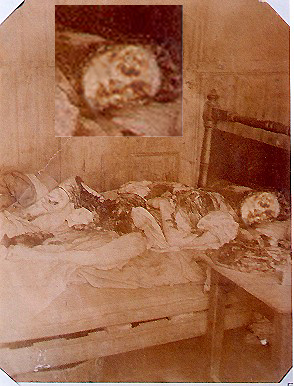 |
Author: Christopher T George
Wednesday, 06 December 2000 - 12:06 am |        | Hi, Grailfinder:
Thank you for posting this interesting image which restores the humanity to Mary Jane Kelly that was so cruelly stolen from her. I appreciate it.
Chris George |
Author: Caroline Anne Morris
Wednesday, 06 December 2000 - 03:24 am |        | Magical stuff Grail,
Mary, in peaceful slumber at long last - I'm sure she would also appreciate your thoughtfulness and effort.
She's beautiful.
Love,
Caz |
Author: Simon Owen
Wednesday, 06 December 2000 - 02:46 pm |        | Grail , thats an excellent piece of work and I can only agree with Chris and Caroline and echo their sentiments. It is a nice thought to think we are perhaps gazing on her face for the first time in 112 years , and that she is restored to her dignity once again.
I'd like to have a go at a portrait , and also have a go at rendering Kelly's room in a perspective sketch - when done , I will post the results here. |
Author: Steve
Wednesday, 06 December 2000 - 02:57 pm |        | Hi All
A little detail that got lost in yesterdays post.
The key to the diagrams is as follows:
A=Position of 1/2 plate camera.
B=Position of key light source.
C=Position of 1/4 plate camera.
Chris,
Thanks for the comments and the additional info on the position of the washstand. I have to admit that the results came as a surprise as I'd always thought that the bed was much closer to the partition.
I'm no photographic expert but I wonder about the idea that the bed was moved to aid the photographer, as the second photo(towards the door) is of a different format size(1/4 plate). I believe that this camera would have been a much more compact size (about the size of the old Box Brownie) which could have been hand held.
Moving the furniture appears to have made the photographers job more difficult for the larger photo in that the camera would be very close to the back wall . Wouldn't it have been easier to move the table to the bed to get the same photo?
If and it's a big 'if' the photo shows the position as the scene was found,it could explain how the murderer was able to carry out the mutilations to both sides of the body as well as how sufficient illumination was gained from the fire.
One thing I still can't fathom is the 'thingy' under the bed. Is it just a 'Guzzunda' and if so when the bed was squared to the wall it would have been at the side of the bed in the middle of the floor.
What were the dimensions of a quart drinking pot?
Grail,
You lucky devil having Photoshop too expensive for me!
Nice piece of work .
One comment though ghastly though it appears, I think that the area you show a the chin is in fact the severed part of the neck, that is to say the features need to be moved up and rotated to the left side of the skull.
I understand your problems as to the location of the left cheek. I think the problem is that as the large muscles in the neck have been cut the head has been rotated left to an unnatural position.
Simon,
Sorry I couldn't be more helpful as to the size of the body . I think the model needs to be carried out at a larger scale to give any accurate data sufficient to establish the height of the body to within the inch.
The ideal solution would be a full size set up using cameras of the same format and the assistance of someone with medical/anatomical knowledge.
Steve |
Author: Caroline Anne Morris
Wednesday, 06 December 2000 - 05:03 pm |        | Hi Steve,
A quart is two pints, or a fourth part of a gallon (1.14 litres). In other words, twice the size of the usual pint beer glass or jug.
I'm here again because I'm mesmerised by Grail's new image of Mary. It may be the drink talking now, but there is even an Irish look about her features - quite breathtaking.
Love,
Caz |
Author: Wolf Vanderlinden
Wednesday, 06 December 2000 - 05:23 pm |        | Hello C-G and Steve.
C-G, I know that you have expressed the opinion that the contemporary newspaper sketch titled, ‘The Murdered Woman's Room', (from Reynolds Newspaper, 18 November 1888), shows a factual representation of number 13 Miller's Court but I have always had my doubts. Reynolds, as far as I know, is the only newspaper to mention the washstand, other newspaper accounts do not. The Illustrated Police News comments on the room being, ‘scantily furnished' and that it contained, ‘little besides a bed, a rickety table and a couple of chairs.', The Times says much the same thing, "It was a very poorly furnished apartment, about 12 ft. square, there being only an old bedstead, two old tables and a chair in it." Given the small size of the room I doubt that it could have comfortably held more than this. There is some indication that the room also contained a built in cupboard next to the fireplace, this is where the ginger beer bottles were supposedly found, and there might be truth in Tully's observation that the top of this cupboard was used as a washstand.
Unfortunately Abberline's list of the contents of the room has not survived or at least has not been found but we do have some indication of the area around the bed. Dr. Bond gives us a couple of good clues, one being the mention of the wall being marked by blood, "which had struck it in a number of separate splashes." Indeed, the "initials" are, in all likelihood, these self same splashes of blood which would have struck the washstand had it been in the position shown in the Reynolds drawing and where you think it might have been.
Also, and more compelling, is Bond's report to Anderson in which he states, "...In the Dorset Street case, he must have attacked in front or from the left, as there would be no room for him between the wall and the part of the bed on which the woman was lying." No mention of a washstand being in the way but, if a washstand, which would be the size of a small table, had been placed between the wall and the bed, there would have been ample room to have maneuvered in the space provided. Bond makes it clear that there was either no, or very little gap between the bed and the wall.
Wolf. |
Author: Grailfinder
Wednesday, 06 December 2000 - 05:36 pm |        | Hi all;
Thanks for all your comments, I agree with all you say about restoring Mary Janes humanity and dignity, It wasn't until I came to do these reconstructions, that I realized just how desensitized I had become when looking at JtR related images, we all get so familiar with the same photos appearing in yet another new book, that it is easy to look but not see!
When I came to do the recon's, it meant having to study the ladies bone structure and features for a couple of hours, and there individual personalities, traits, mannerisms etc, were questions that I constantly wondered about whilst doing the work.
I have included another of my recon's, this time the Lady in question is Liz Stride. ("I know this board is for Kelly based topics, but thought it best to keep the images together")
Although not as badly mutilated as Kelly, Stride caused me problems of a different sort.
The only images of Liz that I have seen or know of? are the two in the pic below, The Photo is a problem because of the angle of tilt of the head, She also appears to have been washed down?
Her hair looks very wet and matted, and not in the style Liz would have worn her hair.
I decided to use a little Artistic license, and came to the conclusion that there is a good chance that the Artist, employed to draw the sketch of 'The Berner Street Victim', could have been working from a description of an acquaintance of Strides, and so I choose to portray Liz as a composite of these two pictures.
Again I must stress, these images are only my views of what these Women looked like.
Pic 1; "These two images provided the source for the Reconstruction of Liz Stride"
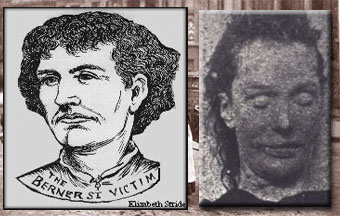
Pic 2; "The Reconstructed Stride"
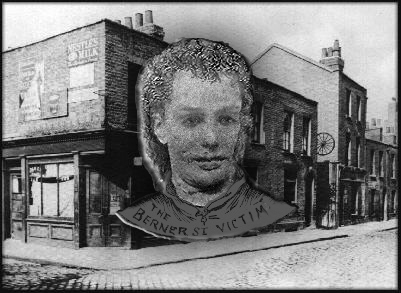
Pic 3; "Another Reconstruction of Stride"
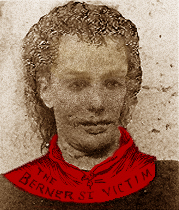 |
Author: Diana
Wednesday, 06 December 2000 - 06:03 pm |        | | Is it possible that Jack moved the bed out from the wall in order to facilitate the mutilations? |
Author: Jon
Wednesday, 06 December 2000 - 08:32 pm |        | The Illustrated Police News of Nov. 17th, 1888.
(a copy of which is in the A-Z, 3rd edition)
Has a graphic representation of the scene in #13 at the time the Doctors were investigation the remains on the bed.
The etching shows three Doctors with their backs to the viewer and one other Doctor on the opposite side of the bed, between the bed and the wall. If this is a factual representation then it provides the most logical reason for pulling the bed away from the wall, to facilitate the medical investigation of four Doctors (Phillips, Brown, Bond, Duke) around the bed.
Regards, Jon |
Author: Diana
Wednesday, 06 December 2000 - 09:28 pm |        | | Looking at the Stride reconstruction, I have had something brought into focus that has always bothered me at some level. Why do her lips have that funny mashed look to them? (I'm not trying to be facetious.) |
Author: Grailfinder
Thursday, 07 December 2000 - 07:54 am |        | Hi Diana;
When I came to do the Stride Reconstruction, I was tempted to alter the lips more than I did, but decided it was best if I left them as they are.
I did straighten the top left lip slightly thinking that strangulation could have bought on the deformed look but then remembered one of Lizzie's stories?
Her lip deformity was caused "according to Liz" by the heavy boot of a man trying to save himself from drowning in the 'Princess Alice' ship disaster.
Stride had claimed (or tried to claim) relief monies from a charity fund set up for survivors of the sinking ship. (600 Died)
She claims to have lost her husband and child in the wreck (no records for this event).
The boot in the face, left Liz with a deformed Pallet and scaring to the mouth.
I do not have any ref; with me at the time of writing this, and the above story is from memory, so perhaps another member can send you a more detailed account of the accident and Liz Strides claims of being on the ship and the injuries she received from this panic stricken mans boots.
Hope this answers your question about the lips looking deformed, and that you agree with my decision to leave them alone in the reconstruction?
cheers,
P.S
I might add, that the 'reconstructions' were done about four years ago, as an exercise with the software 'Photoshop'
I was new to this Art/Photo Manipulation Program and its tools, so decided to practice on these and other photos to hone my skills.
("Yes! some of the "other photos" include the other victims, but I have misslaid them, they are on my system somewhere and will try an hunt them out, should anyone be interested in seeing them?")
With hindsight, and four years experiance with the software, I know I could do a better job of the reconstructions now, and may have another attempt sometime in the near future.
|
Author: Stepan Poberowski
Thursday, 07 December 2000 - 09:26 am |        | 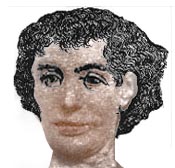
Hi all, hi Grailfinder
I think that the similar freaks can be created in plenties if to be skilful in a photomontage in Photoshop. But it is not photoreconstruction. We can not receive by such way a representation about real features of the victims.
All best,
Stepan |
Author: Grailfinder
Thursday, 07 December 2000 - 10:17 am |        | Hi Stepan;
er, haven't I already stated this?
In both of my posts, I point out that the reconstructions are not to be taken as factual, they are just one mans ideas and I agree that we could never create a true likeness of the victims, for eg; 'The Stride Pic'
In the only photo we have of Stride, her eyes are closed, and this to an Artist is a problem!
The eyes are, they say, 'The windows to the sole' and the tiniest wrinkle or slant of the eye can totally alter the features of the face.
With Liz, I had to search through hundreds of Pictures in order to find a pair of eyes that matched both her age and pose. ("not an easy task")
The purpose for my 'reconstruction/Photo Manipulation' was more to do with giving the Women a human face, ("unlike your 'Freakish' Cartoon above") rather than just seeing them as 'Victims/Bodies', as I feel their Humanity is sometimes overlooked by the whole Ripper Saga, and it is slowly becoming 'The Jack and Kelly Show' with all other victims becoming Toothless, Hobnail Boot wearing old crones, which is not something I personally agree with.
To recap then, These images should NOT be taken as Factual, they are just my thoughts and views of what these Ladies could have looked like prior to there meeting with Jack.
Cheers |
Author: Steve
Thursday, 07 December 2000 - 03:11 pm |        | Hi All,
Jon
I think we have to take the drawings in the IPN with a very large pinch of salt as they were only intended to covey to the eager public the sensational events ,not a factual representation of the scene.
Diana
I agree with you as to why the murder may have moved the bed to get better illumination from the fire. If this was the case it may also indicate something of the killers psychological make up. As I mentioned in an earlier post both the bed and the table have been neatly placed to within a degree or so of parallel. This is similar in character to the arranging of the length of intestine at the side of the body in the Mitre Square case and may also be applied to Hanbury St, if the reports on the arrangement of the personal items is correct.
Does this tidy (using the term in its widest sense)geometric mind point to a particular trade or profession ?
Caroline
Go to the bottom of the class and look up calculating volumes PIr2h (only joking!). If the average pint pot was 7" tall I agree you could get 2 pints in a 14" pot of the same diameter, a bit big for comfortable drinking. The question is what were the proportions of a 2 pint pot?
Wolf
I like you have wondered about Dr Bond's comments as to the close proximity of the bed to the partition. The same terms were used by Dr Phillips to describe the position of the table to the bed and the bed to the partition, when he gave evidence at the inquest.I think that the term close is very much open to interpretation.
The question still remains is why did the coroner specifically ask a witness if she had heard "beds or tables being pulled about". Clearly he was aware of some evidence that these pieces of furniture had been moved.
If the bed had been moved to the position shown and nothing touched as was implied by Dr Phillips and in newspaper reports until the scene was photographed. The 'thingy' under the bed was either placed there by the murderer ,or the 'thingy' was in the middle of the floor close to the edge of the bed and the bed moved over it.
Steve |
Author: Wolf Vanderlinden
Thursday, 07 December 2000 - 03:32 pm |        | Jon, it is difficult to say how factual newspaper illustrations were. No journalist or artist was allowed to get anywhere near 13 Miller's Court at the time of the examination of the body so it is certain that this drawing does not represent first hand knowledge. Having said that, I agree that your observation is quite possible in that it is clear from both Dr. Phillips and Dr. Bond that they had examined the blood on the floor by the partition, next to where the throat had been cut. The easiest way to do this would be to pull the bed out from the wall rather than have Victorian doctors get down on their knees to peer under the bed.
It is obvious, however, from that same edition of The Illustrated Police News that the artist did indeed go to Miller's Court and sketch number 13 from the Court itself as he sets the positioning of the windows and door and the drain pipe, correctly. One other interesting point, one that I have commented on before, is the drawing of the photographing of the body. The position of the body on the bed with the right hand resting on the stomach is a mirror image of the actual photograph
of the body of Mary Kelly. If I had to guess, I would say that the artist had been shown the glass negative of the photograph and had drawn his sketch from that.
Wolf. |
Author: Grailfinder
Thursday, 07 December 2000 - 04:31 pm |        | Hi all;
The "Thingy" under the bed has always been a problem with me? My guess is that it is an old Tin Bath and I have often wondered who put it there, 'Jack or the Photographer'?
In my view, the Bath is responsible for the angle of the bed. If you compare the uprights and verticals of the table, against the verticals of the Headboard, there is a marked difference.
It looks to me, that either Jack propped up the bed at the bottom right corner, so as to allow the blood to run into the far corner and away from his feet, or the Photographer used the Bath and table and possibly turned Marys head towards the camera to complete his ideal composition.
The Photo of Mary on the bed is a little to perfect for my liking, we see the whole scene in one shot, from head to toe with all of Marys extra bits in full view, I very much doubt that this scene is the result of chance, and feel we either have Jack or the Photographer to thank for this composition.
But where was the Tin Bath prior to it being moved? I very much doubt it was in the center of the room, nor under the bed at the time Mary was entertaining a customer! as the bed is sitting on top of the bath and would have rocked and made more than enough noise to have been mentioned by her neighbors, but then again, these neighbors never mentioned smelling anything burning, which is a surprise to me! or was the burning of cloths a usual pastime of Marys? I doubt it, so why didn't anyone smell burning? particularly the woman upstairs and directly above Marys room who probably had a fire and chimney adjoining Marys?
So where was the bath prior to the murder? My guess would be at the foot of the Bed, which would mean anyone trying to get round to the opposite side, would need to move the bath first, possibly leaving it in the middle of the room, and then, lifting the bottom of the bed and swinging it to his right, would place the bed on top the bath as we see in the photo, and giving either Jack room to work, or the Photographer somewhere to stand while he took the second shot of the Kelly C/S.
These questions are important to the true value of the photo, the answers will either tell us more about Jacks MO and his ability to think on his feet and utilize items to his advantage, or should the Photographer be responsible, then the photos value as a true account of the C/S has to be rethought.
cheers. |
Author: Jon
Thursday, 07 December 2000 - 05:25 pm |        | Steve / Wolf
The drawings in the IPN are mentioned simply because they exist and must be considered, even though any reasonable person can make allowances for them being either factual representations or imaginative creations. Even possibly a bit of both. All options are to be considered.
I purposefully made no mention of the 2nd dwg from the left (on the IPN page) because this appears so faithfull to life and yet opposite to what we know.
On seeing this dwg of a photographer taking a picture, many years ago, I also thought this is taken from a glass plate reversed. But then why would another person take a photo of a person taking a photo? There was only one photographer present, that we know of.
It could easily be a composite picture of a reversed glass plate image with the photographer superimposed, for reality?.
Regardless, these press images are invaluable for both style and content, even the faces of the Doctors are taken from life, they are actually made to represent those present, which may or may not be some indication that a witness was indeed present. A verbatim description from one who was present is quite possible.
Regards, Jon |
Author: Wolf Vanderlinden
Thursday, 07 December 2000 - 06:14 pm |        | Steve,
I would agree that the word ‘close' can be open to interpretation, as in, "my house is close to College Street" but not in this case. I think that it is pretty clear from what Dr. Bond had to say to Anderson, that, "...there was no room for (the murderer) between the wall and...the bed," that he meant exactly that. As you pointed out, Dr. Phillips, in his inquest testimony, stated, "On the door being opened it knocked against a table, the table I found close to the left hand side of the bedstead and the bedstead was close up against the wooden partition." I would argue that the term ‘close up against' does not mean, ‘pulled away from the wall' or ‘on an angle from the wall.' In fact, had the bed been pulled from the wall, why didn't either Bond or Phillips mention the fact?
You bring up an interesting point with the Coroner's question to Elizabeth Prater:
Coroner: Did you hear beds or tables being pulled about?
Witness: None whatever. (From, The Daily Telegraph, Tuesday, November 13, 1888)
I can't comment on it as I'm not exactly certain that this is what was asked of the witness. The official inquest report does not contain the Coroner's question only Prater's answer, "I heard nothing else whatever.", while The Times also only records her answer as ...neither did she hear a sound of falling....
It seems pretty clear from the eye witnesses and the photograph of the body that the bed was up against the partition and not pulled away from the wall. There is absolutely not a single piece of real evidence to indicate otherwise.
Jon, my interpretation of the drawing is that the artist got a look at the glass negative in order to get a sense of what the body looked like and the rest, the photographer taking the picture, was artisitc license.
One final thought. If the wooden partition ran along most of the wall next to Kelly's bed, and the partition was made up of old doors, as the photograph shows, (remember, Elizabeth Prater stated at the inquest that she could see light through the cracks as she went up the stairs,)then it is possible that the police or the photographer merely pulled off part of the partition and took the second photograph without moving the bed or table at all.
Wolf. |
Author: Scott Nelson
Friday, 08 December 2000 - 01:00 am |        | | It may have been easy to remove a portion of the partition against the bed to photograph Kelly at the angle of the second photograph, maybe not. The question we have to ask is why would the police have done it, instead of simply moving the bed away from the partition (not enough room to set up?). Is there some clue the police wanted to capture in a photographic image by undertaking this possible extraordinary effort? I don't think it would necessarily have been to capture the image of MJK's split left thigh bone, but who knows. There is no surviving police documentation to suggest why this second photo was taken at such a peculiar angle. |
Author: Jon
Friday, 08 December 2000 - 07:49 pm |        | Though it does no harm to speculate on such possibilities, I dont believe the police had the same regard for preservation of evidence (move the wall, rather than the bed?) in those days.
The bed most likely had to be moved by the Doctors, the question though is, "was it already moved away from the wall, when they opened the door?".
Taking into acount the blood splashes, I would suggest not.
We can recall Phillips stating that on opening the door, it banged against the table. Which might lead some to think that the table was placed immediately behind the door. Meaning Jack left by the window? (not likely).
If the bed had already been pulled away from the wall any room required for the door to swing open would have been even more restricted.
In contemporary report we learn that Phillips started to investigate the remains while the photographer was sent for. So, I would suggest that when the medical team had done, only then did the photographer set up his tri-pod and take those memorable photo's.
Regards, Jon |
Author: Steve
Sunday, 10 December 2000 - 02:37 pm |        | Wolf
Good point about the Telegraph version of the inquest,but why would the reported include such a question if it was not asked? I can't see what would be gained by including such misreporting.
The question as to if the bed was pulled away form the wall when the door was opened. You rightly point to Dr Bond's findings to Anderson.
Dr Bond only states "The attack was made..." we don't know in what context the note was written.
I think it's safe to assume that Anderson was aware of the details of the crime scene and that the note from Dr Bond was intended as a comparison of the killers modus operandi.
If we take the statements of Dr's Philips and Bond who both position the bed close to the partition and close to the table, what are we to make of the statement of Dr Bond, that the door struck the table on being opened? also Bowyers comment that the table was close to the bed when he looked through the window.
Both of these indicate that the table was within the arc of the door and therefore the gap between the bed and the partition must have been a reasonable dimension.
As I've shown in the diagram posted earlier the gap shown it the photo is about 28" at the head of the bed and with the furniture in this position the table is within the door arc.
On the point of the partition which was described as matchwood I don't think there was any need to remove any of this as the second photo was taken with a smaller format camera which could have been hand held.
Grail,
The thingy under the bed is too small to be a bath. The gap under the bed is only 9" and I would estimate that the diameter of the thingy is between 6" and 9" . It also has an embossed emblem close to the top possibly a 'cross keys' or similar.Which points to it being something less utility.
I would have thought it unlikely that the people of Dorset St would have had there own bath's. I think they would have had to make use of public bath houses.
Steve |
Author: Grailfinder
Sunday, 10 December 2000 - 03:15 pm |        | Hi Steve
Sorry mate! it was a bad choice of words, on my part.
Perhaps I should have said 'Tub' rather than bath.
The type of thing I have in mind, I remember an Aunt of mine having and was used to wash her smalls and things in.
I agree that the locals would have used the public baths (those that could be bothered with hygiene), but I still feel that whatever it is under the bed, it is responsible for the angle of the bed, and as I pointed out in one of my other posts, it could not have been there whilst Mary Jane was entertaining a client, as the bed would be rocking and making enough noise to have been mentioned by the neighbours.
cheers |
Author: Davidoz
Monday, 11 December 2000 - 08:08 pm |        | The body of our Mary was divided into 13 parts,
though some say 14 ! |
Author: Steve
Tuesday, 12 December 2000 - 01:54 pm |        | Hi Grail
I know the tub you mean.(Sounds like a George Formby song "Aunties washing her small's").
I don't think the tub or whatever it is is responsible for the angle of the bed. The problem seems to be the angle of the verticals of the bed and the door.
I think the answer to this is:
1 The camera was tilted to the right by 1-1.5 Deg.
This is what throws out the panel and door verticals
2 The headboard of the bed is angled back. This may be by design or it could be just a rickety old bed.
Steve |
Author: Steve
Tuesday, 13 February 2001 - 02:28 pm |        | Hello All,
Just a few pictures for you.


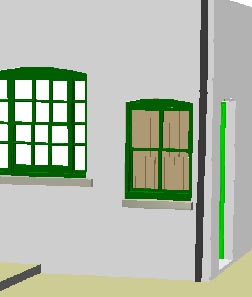
The above are CAD images produced from the data available in the existing photos.
It's now possible to take a virtual tour of the scene as well as get a reasonably accurate estimate of the camera/light locations , and (just for Simon) the height of the body.
A couple of examples.

Bowyers view.

From the fireplace.
Steve |
Author: Christopher T George
Wednesday, 14 February 2001 - 06:49 am |        | Hi, Steve:
Excellent work. My only reservation would be that the bed is surely too small?
Best regards
Chris |
Author: Steve
Wednesday, 14 February 2001 - 03:16 pm |        | Hi Chris,
Thanks for the comments.
I like you thought the bed would have been a double 6'6"x4' instead of the single size I have show 6'6"x3'.
As you can see in the following picture, if the width of the bed is increased to 4' while retaining the other detail (angle of bed ,door size and angle etc). The head of the bed obscures the corner of the room. In order to retain the same perspective the corner formed by the partition and the rear wall would have to be over 90Deg . The problem with this is, if this is done the dado of the rear wall is then thrown out of perspective.
One of the advantages of using CAD is any suggestions can be tried.
I've included one other picture which may be of interest to the 'Missing Key' debate. The picture shows a dimensioned view from the from the lower right window (when viewed from outside) to the door lock.
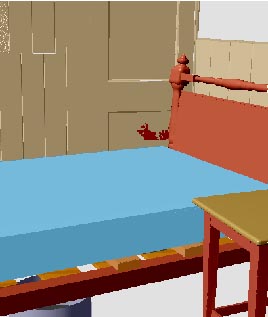

Steve |
Author: Diana
Wednesday, 14 February 2001 - 06:36 pm |        | | The photo of the outside of Millers Court shows the wall with the door in it foreshortened. Was the computer able to somehow detect how far it was from that window to the door handle through some feat of mathematics (entirely possible, it is a strain for me to add two and two) or did you have to input some educated guessing? |
Author: Jim DiPalma
Wednesday, 14 February 2001 - 07:36 pm |        | Hi All,
Nice work, Steve. I am interested in how you arrived at the distance of 1' 6" (~45.7 cm)from the window to the door knob. What dimensions did you use for distance from door to corner, and from corner to window?? How 'bout placement of the door lock??
I ask because the "gorilla arms" theory has been of some interest lately on the other boards, i.e., the theory that the distance was so great that Joe Barnett must have had "gorilla arms" to reach it and MJK may not have been able to open her door in that manner at all. Your figure of 1" 6" would seem to refute the gorilla arms idea, so I think it would be of general interest if you could explain how you arrived at that distance.
Best regards,
Jim |
Author: Jon
Wednesday, 14 February 2001 - 07:58 pm |        | Steve's artwork is a nice job, but the 1'6" is indicated from the lower pane, which was not broken. He should be measuring from the upper pane, which I believe should give a dimension of about 24-26".
Regards, Jon |
Author: Guy Hatton
Thursday, 15 February 2001 - 05:40 am |        | I'm not convinced that the relative height of lock to window is correct here. Looking at the photograph again, it would appear that if one were to reach in through the lower pane, there would be no need to reach down at the angle indicated above - it would be more of a "horizontal" job. Reaching in through the upper pane, on the other hand, would require reaching down to the lock, and the distance does look like more than 18"
All the Best
Guy |
Author: R Court
Thursday, 15 February 2001 - 08:49 am |        | Hi all,
Nice work, Steve.
A point here could also be that we don't know how high the lock was positioned on the door. Although probably placed about the middle as Steve has indicated, that is not proven and it is possible that the lock was placed higher.
In any case we don't know that even if the distance was such that you would not be able to reach through the pane to the lock with the window closed, it could have been opened to allow easy access.
I have begun to wonder if the panes were maybe intentionally broken to gain access after the key was lost rather than in a quarrel. It COULD have been that one pane was broken in a futile attempt to reach the lock, the second then in order to access the catch to unlock the window. Assuming it to have been a functioning sash window (what?), this may have been the solution.
I say that because if the window was broken in a fight/while drunk, the key would not have been lost at that time but later and the access to the bolt wholy fortuitous after it was. I have usually subscribed to the fight/drunkenness theory because two panes were broken, but now I'm not so sure.
Best regards,
Bob |
Author: Steve
Thursday, 15 February 2001 - 03:12 pm |        | Hi All,
I'll try and answer all the questions.
Diana. The computer did the mathematical part using the polar co-ordinate system. Working in the X,Y,Z planes ie 3D. The dimensions for the drawing were taken from the external picture in the "Ultimate" by counting the number of bricks from corner to door,corner to window 1 and window 1 to window 2.
Jim. I've attached a line drawing of the corner as viwed from above. The dimensions are arrived at as above using 9" as the standard imperial brick measure.
Jon. I must admit I'm confused as to which windows were broken.Most drawings I've seen show the lower right as being broken, but Bowyers statement that it was the farthest window doesn't support this.I've included another picture which shows the dimension from the lefthand window to the lock.
Guy. I've placed the lock at 31" from the bottom of the door. The position was dictated by the centre bar of the door.The position of the centre bar was derived from the photo taken looking towards the door where the lower part of this bar can be seen.I've assumed that the bar is 7 1/2" wide and placed the lock in the most likely position.
Bob. Sash windows? As you can see in the diagram they are indeed sash windows I've drawn. I've also included a close up of the lock which is based on a design I remember still being used on the rear doors of houses built before or at the turn of the last centuary.I've shown the finger slider which operated the latch as brass just for clarity. In reality this would have been pressed steel as would the door knob.
Phew! and we haven't even got on to the subject of the height of the marks on the panel door or the 'thingy' under the bed.



Steve |
Author: R Court
Tuesday, 20 February 2001 - 11:18 am |        | Hi Steve,
First of all, the view of the lock you've chosen is pretty much the same as I remember in an old (early Victorian) house I lived in in London, except for the insignificant handle form, here a knob, there a brass-trimmed longer wooden handle with steel core.
The question mark concerning the windows pointed to the word 'fuctioning' rather than the word 'sash', as you correctly point out, they were indeed of this type.
I believe that the right upper and the left lower panes were broken, being too short of time (lies, nothing but lies, ..lazy..) to check it at the moment, which, if true, would increase the distance you have calculated and increase my suspicion, they may have been induced to open the window before reaching the lock.
May I congratulate you on what I consider to be excellent work?
Best regards,
Bob |
Author: Steve
Tuesday, 20 February 2001 - 02:24 pm |        | Hi Bob,
Thanks for the comments. As I've said I'm confused about which windows were broken. I think this all comes about by the use of the word 'Farthest' by Bowyer. Do we know in which context he used the term? The reason I ask is that if it was only used I the court, he could well have been pointing to a diagram where the lower right was indeed the farthest from him.
I've been doing some work on trying to establish the camera/lighting position and from this I'm pretty sure that at least one of the sash windows was functioning.
In the was the camera inside/outside debate it appears that we were all wrong and all right at the same time! More on that tomorrow.
Regards
Steve |
Author: R Court
Tuesday, 20 February 2001 - 03:12 pm |        | Hi Steve,
About Bowyer's 'Farthest', I think it pretty certain that he was refering to the left side of the right window. He would have entered the court either from the front, or the side, exit of no. 26, being sent by McCarthy as he was to try to collect Mary's rent.
This means he would have first gone to Mary's door (as was stated by him) and then round the corner to the first (i.e. right) window. I, and I think it reasonable to suppose most others, would think of 'farthest' as being that point beyond which I did not go, and that was the left side of this window. I say that because he (Bowyer) stated that he pushed the curtain (Harvey's coat) aside, saw the dreadful scene and fled back to McCarthy.
Best regards,
Bob |
Author: Steve
Wednesday, 21 February 2001 - 02:06 pm |        | Hi All,
INSIDE OR OUTSIDE?
Follows a few diagrams which show the location of the camera when the SOC photo was taken.
First a quick explanation.
Diagram 1 shows the view looking through the wall into the room. The letters and lines are:-
a= The datum (centre of the photo plate) point taken from the full size photograph projected onto the panel door.
b,c= Targets placed at different distances,lined up over 'a'.
Red line = Line drawn from 'a' through 'b' and 'c'.
d,e= Lines at 90 Deg to 'Red Line' from points 'b' and 'c'
f,g= Targets placed on lines 'bd','ce' placed where the centre of the target is on the horizontal limit of the photograph.
Blue line= Line drawn through the centre of points 'f' and 'g' through the intersection with 'Red Line'.
x= Intersection of 'Red' and 'Blue' lines (focal point of Photograph).
Diagrams 2 and 3 show the same from different angles.
As can be seen the photographic plate (shown to scale) is positioned on the widowsill of the larger window. So the answer to the question was the camera inside or outside is yes and no.
As a firm believer of the inside theory I'll have to admit to being half wrong (or is that half right). It appears the photographer didn't use a tripod but instead simply placed the camera on the sill of the open window.

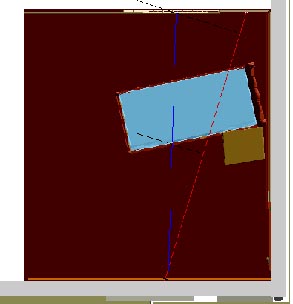
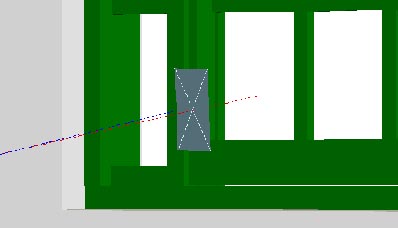
Regards
Steve |
Author: Steve
Wednesday, 21 February 2001 - 06:03 pm |        | Hi All,
First of all apologies for the loss of some of the detail in the diagrams in my last post, I'm afraid compressing the 1.5 Meg originals to files under 250k has taken it's toll.
Follows another couple of diagrams showing the possible locations of the key lighting source for the SOC photograph.
The results are based on projecting the plane of light which produced the strong shadow on the bedstead under the mattress.
As can be seen the light source can be any position on the plane shown in yellow however some areas can be discounted. These are :-
The area within the view of the camera.
The area to the right of the table as no shadow is cast by the table.
My favoured position for the light source would be next to the camera through the open window of the larger widow.
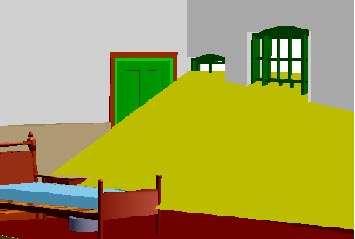
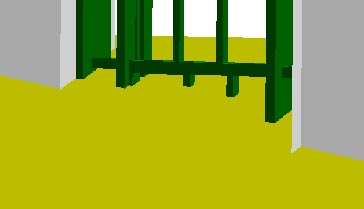
Regards
Steve |
Author: John Omlor
Wednesday, 21 February 2001 - 06:11 pm |        | Forgive the interruption, but this seems the best place to ask the question. In Stewart Evans' accounts of the crime scene photographs there is the folowing note:
[NB the same file page contains the photographs of Nichols, Chapman, Eddowes standing against the wall, and the second Kelly photograph taken from the opposite side of the bed - ref. NSY/MJK3].
Are these photos all available at any specific website or place online that anyone knows about?
A private answer can be sent to omlor@aol.com, if this is not the place to post a response.
Thank you
--John |
|
 |
 |
|